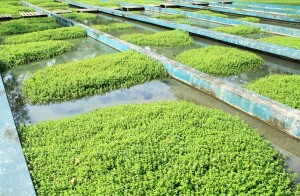Submitted by The Evergreen State College
 If utility managers, transportation planners, scientists and politicians can agree on one thing, it is that American infrastructure is aging.
If utility managers, transportation planners, scientists and politicians can agree on one thing, it is that American infrastructure is aging.
The Pacific Northwest faces a growing public infrastructure crisis of deteriorating facilities, escalating maintenance costs and shrinking resources for investment. The region could, however, become a national innovation leader by developing sustainable, resilient, and affordable, infrastructure systems, according to findings of a new report from the Center for Sustainable Infrastructure (CSI) at The Evergreen State College.
“We are going to spend many billions of dollars on our infrastructure just to keep our society and economy functioning. This is the reality. The question is: how do we get smart about how we’ll invest that money?” said CSI Director, Rhys Roth.
Increasingly, infrastructure professionals recognize that innovation is needed, according to the report, Infrastructure Crisis, Sustainable Solutions: Rethinking Our Infrastructure Investment Strategies.
CSI interviewed 70 Pacific Northwest infrastructure innovators and thought leaders with expertise in energy, transportation, water, waste, and infrastructure finance. The report distills their insights to provide guidance to the region’s current and future infrastructure leaders, policymakers, and change agents.
A key conclusion: infrastructure spending decisions need to be rethought at the earliest stages. ”Smarter investment decisions will help us develop systems that most benefit communities for the long-term,” said Roth. The report defines smart investments as affordable, resilient, environmentally sound and integrated. “They’re also rich in community co-benefits, including for the local economy,” said Roth.
Christie True, Director of King County (Wash.) Department of Natural Resources and Parks, agrees: “Whether it’s a wastewater treatment plant, a solid waste transfer station or a regional trail network connected to transportation centers, building sustainable infrastructure isn’t a luxury – it’s a necessity. It’s the foundation upon which we can build communities that are better for people, better for the planet and better for our bottom line.”
The report also finds that the workforce in every infrastructure sector is graying. “We’re about to lose an enormous resource of real-world operational knowledge to the coming retirement wave,” says Roth. “We urgently need to inspire and equip a new generation of infrastructure innovators to enter these professions.” Roth sees a wide range of professions with a role to play, from leaders of infrastructure agencies and utilities, to community planners, elected officials, builders and design teams, engineers, technology firms, financiers, advocates and regulators.
Responsive to the market, the report asks how we will power our homes and businesses, access clean water, get where we need to go, and keep waste from harming us in the decades ahead. CSI encourages inter-agency collaboration, use of smart technologies, new ways to harness private sector expertise, and new planning tools to achieve better economic and community results.
The report recommends making tough financial reforms, for instance, accounting upfront for life-cycle costs of a project and reforming lowest-bid procurement practices. Finally, the report examines the positive ripple effect of a paradigm shift on physical and mental health, quality of life, and competitiveness in the global economy.
Mike McCarty, CEO of Association of Washington Cities praised the report as timely and relevant. “Cities are on the forefront of managing critical infrastructure systems and they face the significant challenges of aging systems, a growing population, and significant fiscal constraints. New ways of meeting our infrastructure needs will be needed. Forward thinking like that captured inInfrastructure Crisis, Sustainable Solutions is essential to inventing the future of infrastructure.”
”The report’s ultimate measure of success will involve an evolution toward healthy, prosperous, beautiful, and cohesive communities,” said Roth. “Our hope is it will prove useful to public, nonprofit, academic, and industry leaders as they help Northwest communities transform how they think about, plan for, and invest in their infrastructure assets.”
Examples of integrated Washington infrastructure projects:
The City of Spokane faced a daunting price tag to comply with Clean Water Act regulatory requirements to prevent untreated storm water and sewage from flowing into the Spokane River during storm events. Nearly 55 million gallons a year of combined sewage and storm water, and a billion gallons of untreated storm water, enters the Spokane River. The standard response, building a bigger water treatment system, would cost $450 million. Instead Spokane developed an Integrated Clean Water Plan with major investments in green infrastructure. The Plan commits the City to deliver a cleaner river faster, but at a savings of about one-third. By connecting planning for multimodal, walkable streets with planning for street-side green storm water infrastructure and for the pipes underneath, the City is able to achieve efficiencies and multiple benefits when working on a given street segment.
Levees and dikes built to control river systems are another water-related infrastructure system that many communities are taking a fresh look at, finding that pulling back the confinements and restoring natural floodplain functions can deliver overall benefits in some cases. Yakima County in central Washington and its partners, for example, are undertaking a variety of levee setbacks, habitat improvements, and infrastructure modifications to restore and enhance the Yakima River floodplain.


















































